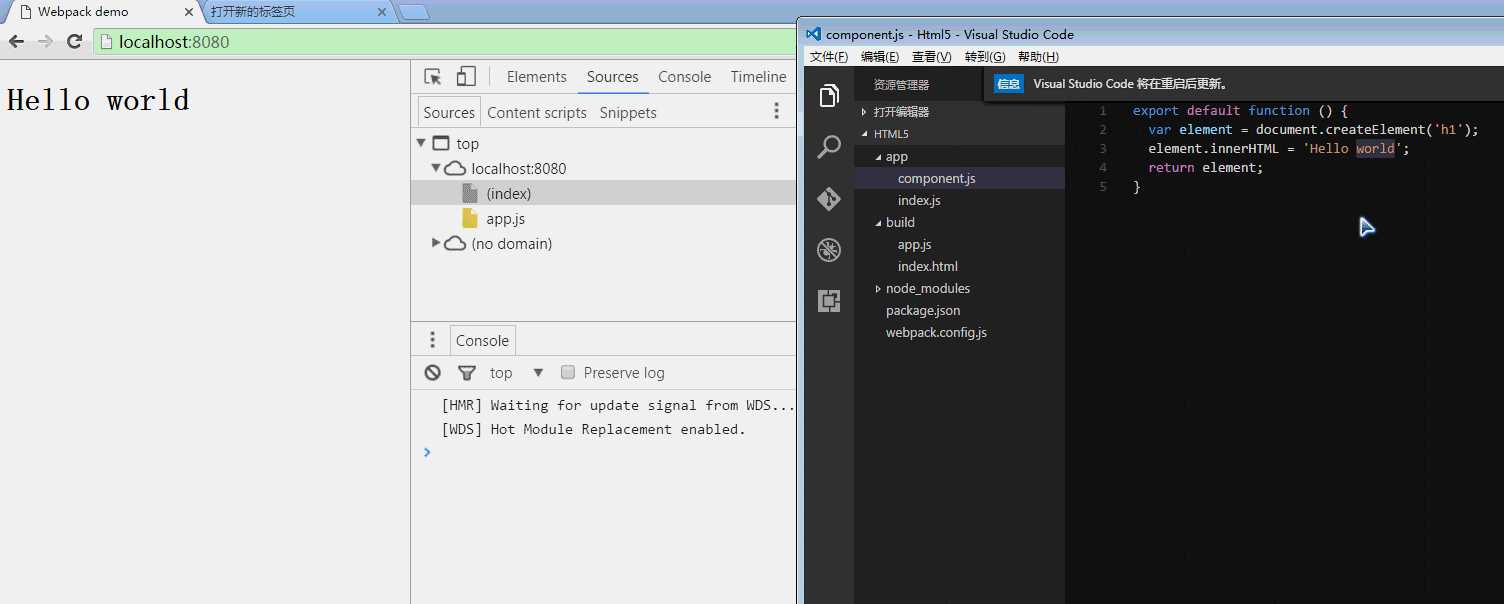标签:需要 tps 打印 dev pos server tap hot log
全称是Hot Module ReplaceMent(HMR),理解成热模块替换或者模块热替换都可以吧,和.net中的热插拔一个意思,就是在运行中对程序的模块进行更新。这个功能主要是用于开发过程中,对生产环境没有任何帮助(这一点区别.net热插拔)。效果上就是界面的无刷新更新。
HMR基于WDS,style-loader可以通过它来实现无刷新更新样式。但是对于JavaScript模块就需要做一点额外的处理,怎么处理继续往下看。因为HMR是用于开发环境的,所以我们修改下配置,做两份准备。一个用于生产,一个用于开发。
const path = require(‘path‘); const HtmlWebpackPlugin = require(‘html-webpack-plugin‘); const webpack = require(‘webpack‘); const PATHS = { app: path.join(__dirname, ‘app‘), build: path.join(__dirname, ‘build‘), }; const commonConfig={ entry: { app: PATHS.app, }, output: { path: PATHS.build, filename: ‘[name].js‘, }, plugins: [ new HtmlWebpackPlugin({ title: ‘Webpack demo‘, }), ], } function developmentConfig(){ const config ={ devServer:{ //使能历史记录api historyApiFallback:true, hotOnly:true,//关闭热替换 注释掉这行就行 stats:‘errors-only‘, host:process.env.Host, port:process.env.PORT, overlay:{ errors:true, warnings:true, } }, plugins: [ new webpack.HotModuleReplacementPlugin(), ], }; return Object.assign( {}, commonConfig, config, { plugins: commonConfig.plugins.concat(config.plugins), } ); } module.exports = function(env){ console.log("env",env); if(env==‘development‘){ return developmentConfig(); } return commonConfig; };



plugins: [ new webpack.HotModuleReplacementPlugin(), new webpack.NamedModulesPlugin(), ],

import component from ‘./component‘; let demoComponent=component(); document.body.appendChild(demoComponent); //HMR 接口 if(module.hot){ module.hot.accept(‘./component‘,()=>{ const nextComponent=component(); document.body.replaceChild(nextComponent,demoComponent); demoComponent=nextComponent; }) }
并修改component.js:
export default function () { var element = document.createElement(‘h1‘); element.innerHTML = ‘Hello webpack‘; return element; }

这个时候页面更新了。每次改动页面上都会增加一个带有hot-update.js ,类似于下面这样:
webpackHotUpdate(0,{ /***/ "./app/component.js": /***/ (function(module, __webpack_exports__, __webpack_require__) { "use strict"; Object.defineProperty(__webpack_exports__, "__esModule", { value: true }); /* harmony default export */ __webpack_exports__["default"] = function () { var element = document.createElement(‘h1‘); element.innerHTML = ‘Hello web ‘; element.className=‘box‘; return element; }; /***/ }) })
通过webpackHotUpdate对相应模块进行更新。0表示模块的id,"./app/component.js"表示模块对应的name。结构是webpack(id,{key:function(){}})。function外带了一个括号,不知道有什么作用。webpackHotUpdate的定义是这样的:
this["webpackHotUpdate"] = function webpackHotUpdateCallback(chunkId, moreModules) { // eslint-disable-line no-unused-vars
hotAddUpdateChunk(chunkId, moreModules); if(parentHotUpdateCallback) parentHotUpdateCallback(chunkId, moreModules); } ;
小结:从结构来看,一个是id,一个是对应修改的模块。但实际执行更新的是hotApply方法。热更新整个机制还是有点复杂,效果上像MVVM的那种绑定。有兴趣的可以深入研究下。不建议在生产使用HMR,会让整体文件变大,而且对生成没有什么帮助,在下一节会讲样式的加载,style-loader就是用到了HMR。但对于js模块还要写额外的代码,这让人有点不爽。
demo:http://files.cnblogs.com/files/stoneniqiu/webpack-ch3.zip
参考:
标签:需要 tps 打印 dev pos server tap hot log
原文地址:http://www.cnblogs.com/stoneniqiu/p/6496425.html